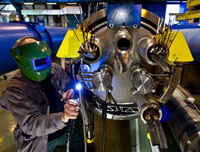Scientists Resume Its "Collision Experiment"
After a hold-up, which lasted for a year, scientists at the world's biggest accelerator have restarted an experiment to recreate "big clash" conditions that had sparked suggestions the earth would be sucked in by millions of black holes.

Scientists at the European Organization for Nuclear Research (CERN) have established circulating particle beams in both directions in the underground Large Hadron Collider, a step that is already beyond where the experiment stalled during a first attempt in September 2008, CERN spokesman James Gillies said.
The high-profile experiment, through which tiny particles are smashed in a bid to learn more about the birth of the universe, failed just nine days after it was launched due to a technical problem that took longer than expected to fix.
"We are further advanced now than where we were after five days of experiment last year," said CERN's Director for Accelerators Steve Myers, saying the extra year had allowed researchers to upgrade instrumentations and computer software.
Myers added that researchers had increased the sensitivity of the protections at the 10 billion Swiss franc ($9.82 billion) collider under the French-Swiss border.
"If anything happens, we would not have the same amount of damage we had last year," he said.
CERN, a 55-year-old organization that counts 10,000 scientists and technicians worldwide working on its research projects, has vigorously rebuffed any suggestion the ground-breaking experiment would cause the world to end.
CERN's Director General Rolf Heuer said getting the experiment re-started had been an "herculean effort."
"We've still got some way to go before physics can begin, but with this milestone we're well on the way," he said.
If things continue to progress at this speed, scientists may be able to accelerate particles at the highest energy level ever tested before Christmas, although high-energy collisions that may shed light on the secrets of the universe would only happen in the new year, Myers said.
The experiment will be fully under way when the particle beams will be smashed at high energy levels. This will most likely happen in January, according to Reuters' report.
Subscribe to Pravda.Ru Telegram channel, Facebook, RSS!


